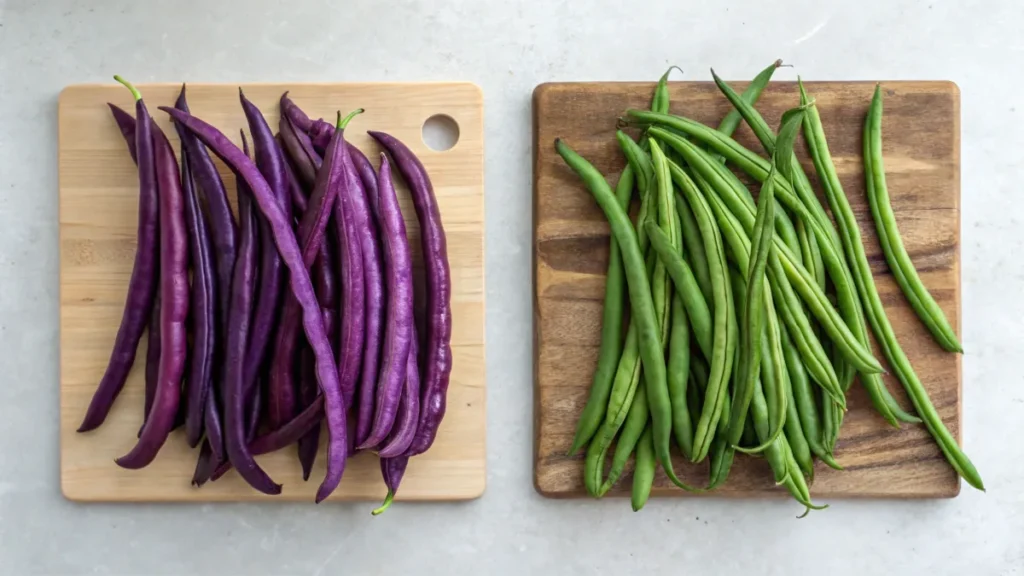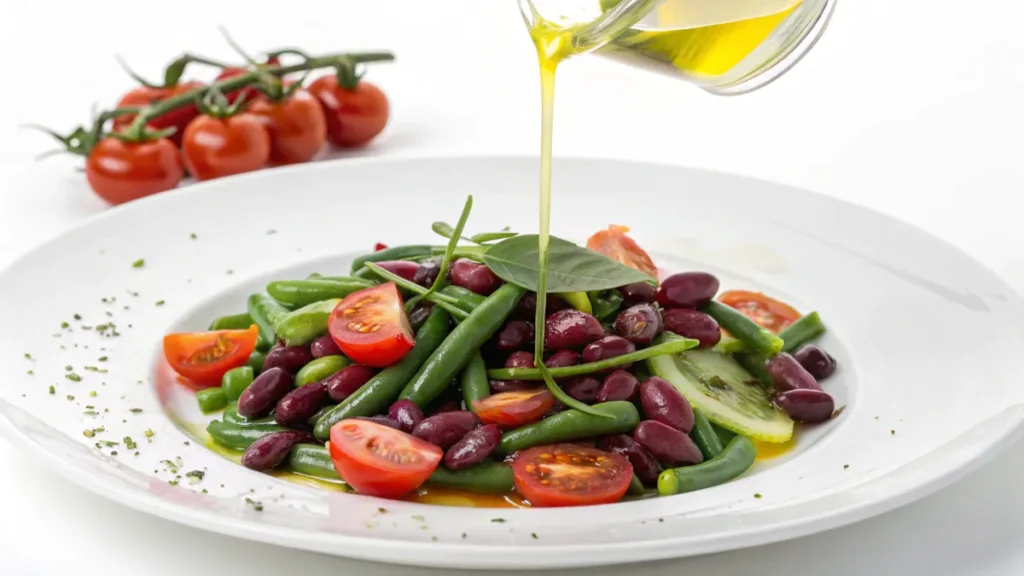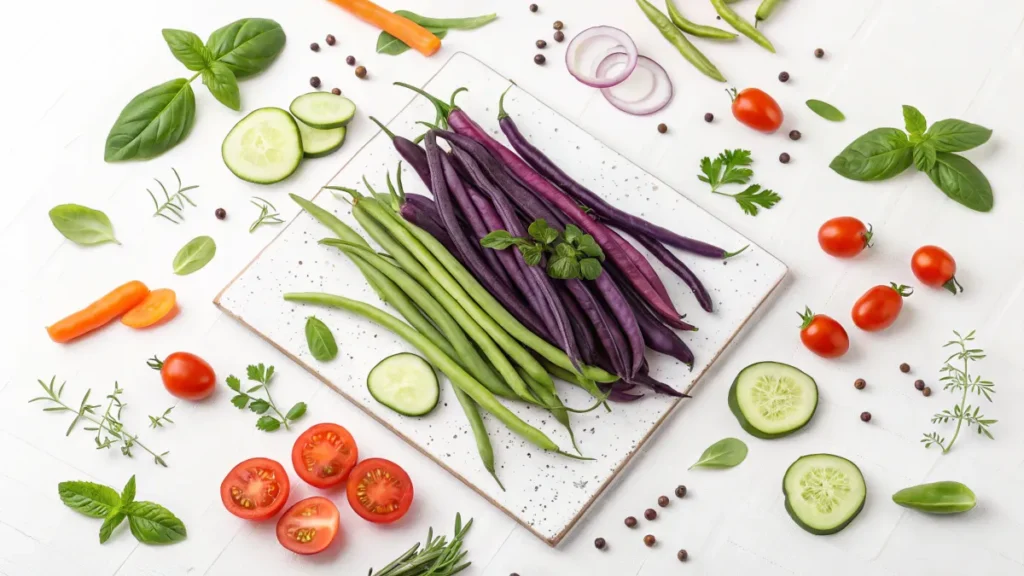Beans are a staple in many diets, offering versatility, nutrition, and a range of flavors. Among the most popular varieties are green beans, known for their fresh and crisp taste. But what about their colorful counterpart, purple beans? Do they taste the same, or does their unique hue bring something different to the table? In this article, we’ll explore the differences in taste, nutrition, and cooking techniques between purple and green beans. You’ll also find answers to frequently asked questions and tips for incorporating these vibrant veggies into your meals.
Table of Contents
Purple and Green Beans
Overview of Purple and Green Beans
Purple and green beans are both members of the common bean family (Phaseolus vulgaris). Green beans are a familiar sight in grocery stores, often steamed, stir-fried, or added to casseroles. On the other hand, purple beans are less common but growing in popularity due to their striking appearance. Despite their differences in color, both types are versatile and can be prepared in various ways.
While green beans maintain their signature color when cooked, purple beans undergo a fascinating transformation. Once exposed to heat, their deep purple skin often turns green, leaving many wondering whether this visual change impacts their flavor.
Appearance and Nutritional Differences
Purple beans are notable for their vibrant color, which comes from anthocyanins. These are natural pigments found in foods like blueberries and red cabbage. Green beans, by contrast, lack these pigments but are still rich in essential nutrients like fiber and vitamin C.
Nutritionally, both beans are similar, but purple beans may offer additional antioxidants due to their anthocyanin content. This makes them not just a feast for the eyes but also a potential boost for your health.
Taste Profiles of Purple and Green Beans
Do Purple Beans Taste Like Green Beans?
At first glance, you might assume that purple and green beans taste the same, but do they really? While the flavor profiles are quite similar, subtle differences do exist. Green beans are known for their grassy, slightly sweet taste with a crisp texture when fresh. Purple beans share much of this flavor but tend to be a bit milder when raw.
Interestingly, cooking purple beans often changes their color to green. This process not only alters their appearance but may also affect how the flavor is perceived. Many people find that purple beans taste closer to traditional green beans once cooked.
Including both varieties in your meals adds vibrant color and unique flavor. For more inspiration, check out this guide to green bean recipes for ways to prepare these versatile vegetables.
Why Cooking Changes Purple Beans’ Color

Purple beans owe their bright hue to anthocyanins, a type of pigment also found in blueberries and red cabbage. These pigments are heat-sensitive, which explains why the beans turn green when cooked. Once the anthocyanins break down, the chlorophyll underneath becomes visible.
This change in color doesn’t alter the core taste of the beans. However, the transformation can be disappointing if you’re looking to keep the beautiful purple hue. To preserve their color, consider eating them raw in salads or lightly steaming them with lemon juice, which helps stabilize the anthocyanins.
Factors Affecting Flavor
Freshness and Harvest Time
The flavor of both purple and green beans depends heavily on their freshness. Beans harvested at their peak tend to be sweeter and more tender. Overripe beans, on the other hand, can become tough and develop a slightly bitter taste.
Seasonal factors also play a role. Beans grown during optimal conditions usually warm, sunny months are often more flavorful. When shopping, look for bright, firm beans without blemishes to ensure the best taste.
Soil and Growing Conditions
Did you know that soil quality can impact how beans taste? Beans grown in nutrient-rich soil absorb minerals that enhance their flavor. Additionally, the growing environment, such as temperature and water supply, affects their texture and sweetness.
For home gardeners, experimenting with growing conditions can help bring out the best in these veggies. Whether you’re growing green or purple beans, providing consistent care and proper soil can make a big difference.
Cooking and Serving Ideas

Popular Recipes with Purple Beans
Cooking purple beans can be an exciting way to add color and nutrition to your meals. However, many wonder, Do purple green beans taste different when prepared using different methods? The answer often depends on how they’re cooked. Purple beans retain their color best when served raw in salads or lightly steamed. This way, they offer a fresh, crisp bite and their natural sweetness shines through.
One popular dish is a purple bean salad with lemon vinaigrette. Adding crunchy nuts and creamy feta complements the beans beautifully. If you’d like more recipes, check out the vibrant bean recipes on websites like Charmed Recipes.
For a deeper dive into using vegetables like beans in soups, you might enjoy this Purple Black Bean Soup Recipe
Cooking Green Beans for Maximum Flavor
Green beans, being more familiar, are often steamed, stir-fried, or roasted. To bring out their best flavor, consider blanching them before tossing them in butter and garlic. This simple method keeps the beans crisp while adding a rich, savory twist.
For those looking for creative ways to enjoy green beans, try a green bean almondine. The toasted almonds and lemon zest elevate the dish’s taste. For other classic ideas, explore additional recipes on sites such as Charmed Recipes.
Nutritional Benefits
Health Benefits of Green Beans
Green beans are low in calories but high in vitamins and fiber. They are a great source of vitamin C, which boosts immunity, and vitamin K, which supports bone health. Their fiber content aids digestion, making them a fantastic choice for a balanced diet.
Adding green beans to your meals is not just a way to eat healthily but also an easy way to enjoy a versatile vegetable. They work well in both simple side dishes and complex recipes.
Are Purple Beans More Nutritious?
The vibrant color of purple beans is more than just appealing. Their anthocyanins the pigments responsible for their hue are powerful antioxidants. These compounds help reduce inflammation and protect against certain diseases. Although purple beans and green beans share many nutritional benefits, the added antioxidants in purple beans give them a slight edge.
For a nutrient-packed meal, consider pairing purple beans with grilled salmon or adding them to a quinoa salad. These combinations are both delicious and nutritious.
Consumer Preferences and FAQs
Do Consumers Prefer Purple or Green Beans?
When it comes to taste and usability, many people wonder, Do purple green beans taste different enough to sway consumer preferences? The answer depends largely on the individual. Green beans are more common and widely recognized for their mild flavor and crisp texture. Purple beans, however, are gaining popularity thanks to their vibrant color and added nutritional benefits.
While some prefer the subtle flavor of purple beans, others stick to green beans for their familiarity. Purple beans are also a favorite among those looking for visually striking dishes, as they stand out beautifully in raw preparations like salads. However, their color change when cooked can surprise those unfamiliar with the phenomenon.
Frequently Asked Questions
Can purple beans be eaten raw?
Yes, purple beans are perfectly safe to eat raw. In fact, eating them raw preserves their vibrant color and crisp texture.
Why do purple beans turn green when cooked?
The anthocyanins in purple beans break down when exposed to heat, revealing the chlorophyll underneath. This process doesn’t significantly change their flavor, but it may affect their visual appeal.
Are purple beans more expensive than green beans?
Purple beans can be pricier in some regions because they are less commonly grown and not as widely available.
Nutritional Comparison

When comparing purple and green beans, the differences may seem minor. However, understanding their nutritional profiles helps make informed choices.
| Nutrient | Purple Beans (per 100g) | Green Beans (per 100g) |
|---|---|---|
| Calories | 35 | 31 |
| Protein | 2g | 1.8g |
| Fiber | 3.2g | 2.7g |
| Vitamin C | 16mg | 12mg |
| Antioxidants | High (anthocyanins) | Moderate |
Both varieties are excellent choices for healthy meals. While green beans are a reliable staple, purple beans offer the added benefit of antioxidants, making them a slightly more nutrient-dense option.
Exploring Flavor Versatility
Purple Beans in Global Cuisines
Purple beans are not just a visual delight but also a versatile ingredient in many global cuisines. From Asian stir-fries to Mediterranean salads, they add a pop of color and mild flavor that complements various dishes. One popular way to use purple beans is in a cold bean salad with olive oil, garlic, and herbs, which allows their natural crunch and sweetness to shine.
You might wonder, Do purple green beans taste different in these recipes? While the difference is subtle, their raw preparation often brings out a slightly nuttier undertone compared to green beans. Light steaming or quick blanching can also highlight their fresh, earthy flavor.
Green Beans as a Staple Ingredient
Green beans have been a culinary favorite for generations. Whether steamed, sautéed, or roasted, they adapt well to almost any cooking method. Green bean casseroles and almondine dishes remain staples during holiday meals, while stir-fries make them a quick, healthy option for busy weeknights.
For a twist, consider pairing green beans with bold flavors like garlic butter or spicy chili flakes. Despite their simplicity, green beans rarely disappoint, offering a reliable choice for cooks at all levels.
Purple and Green Beans
Choosing the Right Bean for Your Meal
The question remains: Do purple green beans taste different enough to choose one over the other? Both varieties are delicious, but the choice often comes down to availability and presentation. Purple beans are ideal for those seeking a colorful, antioxidant-rich option, especially in raw or lightly cooked dishes. Green beans, however, remain the go-to for everyday cooking due to their consistent flavor and versatility.
To learn more about pairing colorful ingredients with other dishes, visit our guide to Colorful Ingredients in Recipes.
Encouraging Variety in Your Diet
Adding both purple and green beans to your meals not only enhances flavor but also boosts nutrition. Mixing the two in salads or side dishes creates a visually appealing plate that’s full of health benefits. With so many ways to prepare them, it’s easy to keep your meals exciting and nutritious.
If you’ve never tried purple beans, why not experiment with them in your next recipe? Their vibrant color and mild taste could be the perfect addition to your favorite dishes.
Sustainability and Availability of Purple and Green Beans
Growing Practices for Purple and Green Beans
Both purple and green beans are relatively easy to grow, making them popular among home gardeners and farmers. Purple beans, in particular, are favored for their natural pest resistance due to the anthocyanins in their skin. These compounds act as a deterrent for certain insects, reducing the need for chemical pesticides.
Green beans, while also resilient, may require more care to avoid pests and diseases. Farmers often employ crop rotation and organic methods to maintain healthy yields. If you’re interested in sustainable gardening, both varieties are excellent options.
If you’re planning to try growing your own beans, our tips on Gardening and Seasonal Ingredients can help.
Market Availability
Green beans are widely available year-round in most grocery stores, thanks to their consistent demand. Purple beans, on the other hand, are often considered a specialty item. They may only appear during peak growing seasons at farmers’ markets or specialty stores.
For tips on sourcing fresh beans or growing your own, consider visiting resources like Charmed Recipes for gardening and cooking insights.
Health and Lifestyle Considerations
Beans for Specific Diets
Purple and green beans are excellent additions to many diets, including vegetarian, vegan, and low-carb lifestyles. Their high fiber content makes them ideal for promoting gut health, while their low-calorie count supports weight management. Adding these beans to your diet is a simple step toward a healthier lifestyle.
For more ideas on versatile bean recipes, check out our One-Pot Meal Recipes.
Cooking Methods for Health-Conscious Eaters
For those focusing on heart health or reducing fat intake, steaming or roasting beans without added oils is a great option. Purple beans can be particularly appealing in raw dishes, preserving their vibrant color and nutrients.
So, Do Purple Green Beans Taste Different?
After exploring their taste, nutrition, and versatility, the question remains: Do purple green beans taste different? While both varieties are mild and slightly sweet, purple beans may have a slightly nuttier flavor when eaten raw. The difference, though subtle, adds diversity to your meals.
Whether you prefer the familiarity of green beans or the visual appeal of purple beans, both are valuable additions to your table. Their nutritional benefits, ease of preparation, and versatility make them ideal for everything from simple side dishes to complex recipes.

